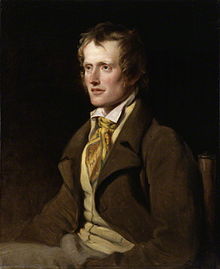John Clare
| John Clare | |
|---|---|

John Clare by William Hilton,
oil on canvas, 1820 |
|
| Born |
13 July 1793 Helpston, Northamptonshire, England |
| Died |
20 May 1864 (aged 70) Northampton General Lunatic Asylum, Northampton, England |
| Genre | Rural |
| Notable works | Poems Descriptive of Rural Life and Scenery |
|
|
|
| Signature | |
John Clare (13 July 1793 – 20 May 1864) was an English poet, the son of a farm labourer, who became known for his celebrations of the English countryside and sorrows at its disruption. His poetry underwent major re-evaluation in the late 20th century: he is now often seen as one of the major 19th-century poets. His biographer Jonathan Bate states that Clare was "the greatest labouring-class poet that England has ever produced. No one has ever written more powerfully of nature, of a rural childhood, and of the alienated and unstable self."
Clare was born in Helpston, six miles to the north of the city of Peterborough. In his lifetime, the village was in the Soke of Peterborough in Northamptonshire and his memorial calls him "The Northamptonshire Peasant Poet". Helpston now lies in the Peterborough unitary authority of Cambridgeshire.
He became an agricultural labourer while still a child; however, he attended school in Glinton church until he was 12. In his early adult years, Clare became a in the Blue Bell public house and fell in love with Mary Joyce; but her father, a prosperous farmer, forbade her to meet him. Subsequently he was a gardener at Burghley House. He enlisted in the militia, tried camp life with Gypsies, and worked in Pickworth as a lime burner in 1817. In the following year he was obliged to accept parish relief. Malnutrition stemming from childhood may be the main culprit behind his 5-foot stature and may have contributed to his poor physical health in later life.
Clare had bought a copy of Thomson's The Seasons and began to write poems and sonnets. In an attempt to hold off his parents' eviction from their home, Clare offered his poems to a local bookseller named Edward Drury. Drury sent Clare's poetry to his cousin John Taylor of the publishing firm of Taylor & Hessey, who had published the work of John Keats. Taylor published Clare's Poems Descriptive of Rural Life and Scenery in 1820. This book was highly praised, and in the next year his Village Minstrel and other Poems was published.'There was no limit to the applause bestowed upon Clare, unanimous in their admiration of a poetical genius coming before them in the humble garb of a farm labourer'
...
Wikipedia
